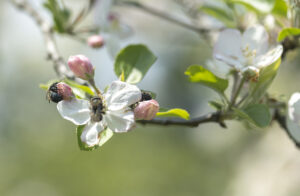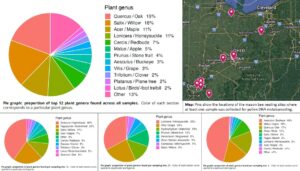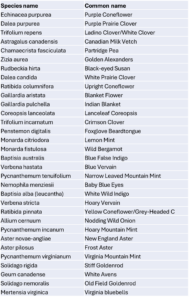Final report for FNC23-1361
Project Information
Justina Block (farmer) is the principal investigator. She is the owner of Osmia Bee Company, a woman-owned business which creates and distributes sustainable and scientifically backed solitary bee houses, bee cocoons, nesting materials, and harvesting accessories to the general public via retailers and direct online sales. It is presently the only commercial supplier of locally adapted mason bee populations available for pollination in Ohio. Justina has worked closely with family-owned fruit orchards in Ohio from 2010 to 2022 using mason bees for pollination services. Through education and advocacy, Osmia Bee Company’s mission is to provide communities with the power to help conserve bees in their backyards. Justina has forged partnerships with many organizations that are committed to supporting bees and other pollinators, including The Cincinnati Zoo and Botanical Garden and Bernheim Arboretum and Research Forest. Justina is the creator and driving force behind "The Pollinator Report," a live webinar series bringing outstanding entomologists, biologists, and researchers together to discuss the future of pollination and our role in preserving the planet. Justina is an active member of the North American Pollinator Protection Campaign; she serves on the Pollinator Communications Task Force, which works to create thoughtful, engaging, and hopeful communications campaigns around the conservation of pollinators and their importance to our ecosystems. Justina is well equipped to oversee this research project and has several existing channels to disseminate the results of our research to stakeholders who would benefit. David Riddell (farmer) with Ohio Prairie Nursery (OPN) Seed will coordinate the production of the seed mix based on our experimental data (pollen sources identified by Penn State). OPN Seed, a family-owned operation, has been producing native grass and wildflower seed for over 23 years for residential and commercial projects. Dr. Natalie Boyle at Pennsylvania State University will use pollen DNA metabarcoding to determine pollen sources used by mason bees to inform the development of an effective seed mix to support spring pollinators of the North Central region. Dr. Jamie Strange at Ohio State University and Cory Christopher, Director of Conservation at the Cincinnati Nature Center, will oversee observation and collection of mason bee nesting reeds; this includes setting up nesting sites in urban and agricultural locations, releasing mason bees at each nesting site via emergence tube, daily observation of nesting bees, collection of filled nests, tagging nests with location and date, and shipping nests to Penn State for analysis.
Bees pollinate 90% of the world’s crops. Their services are valued at $34 billion annually in the U.S. alone (Jordan et al. 2021). The U.S. bee industry focuses its resources primarily on the promotion and support of honey-producing bees. However, the honey bee population has been declining since the 1990’s due to the spread of pests and pathogens, widespread use of pesticides, and global climate change (Gregorc 2020). Many of the highest-valued crops in the U.S. (e.g., almond and cherry) are pollinator-dependent and bloom in early spring when pollinator availability is low because most wild bee species and honey bee colonies are still dormant in all but the warmest parts of the country. Wild bees and managed mason bees are used as a supplement or replacement to honey bees for pollinating various crops. For best crop yields and bee reproduction, supplemental forage is needed to diversify and extend the foraging season of wild pollinators (Pitts-Singer et al., 2019; Boyle et al.,2020). Currently, there is no seed mix available to aid in sustainable production of North Central spring blooming crops and their pollinators.
Literature cited list available upon request.
Solution: This project leverages the rich collaborative network maintained by the Osmia Bee Company and services provided by Penn State’s Honey and Pollen Diagnostics Laboratory to determine the variety and intensity of mason bee foraging on spring flowering plant genera found across Ohio State. Information obtained from the proposed study will be used to 1) develop and produce a custom seed mix that provides support for spring pollinators in North Central climates, and 2) educate the public about how to support and conserve spring bees. In early spring 2023, 30 mason bee nesting sites (natural grass reeds housed by a PVC nest shelter with accompanying mason bee cocoons) will be distributed to partnering individuals and institutions for local installation. Partnering institutions include the Strange Lab (Dept. of Entomology, Ohio State University), Ohio Prairie Seed Company, and the Cincinnati Nature Center. A subset of nesting sites will be distributed to individual volunteers who are knowledgeable in mason bee management and active in the Osmia Bee Company community network. Partners will be instructed to place their hotels in various agricultural (10), natural (10) and developed (10) landscapes. At each site, sixty mason bee cocoons will be released in two equal batches during early and mid-April. Mason bees begin foraging around 55°F and are typically active during early April through May in Ohio. A staggered bee release allows for a longer nesting duration and will improve our capacity to identify plants that bloom before, during, and after orchard bloom. Concurrent with the mid-April bee release, three completed nesting tunnels from each site will be collected, labeled with the location and date, and frozen. The same nesting tunnel collection process will be repeated two weeks later (late April). Remaining nests can be managed according to the husbandry directions outlined on the Osmia Bee Company website. Frozen samples will be mailed to Dr. Natalie Boyle (Pennsylvania State University) via a provided, prepaid shipping envelope. Using an established pollen metabarcoding pipeline, Dr. Boyle’s lab will identify pollen species represented within provided mason bee nests, culminating into a list of which flowering plants best support mason bee reproduction throughout Ohio. In consultation with the Ohio Prairie Seed Company, this data will inform the creation of an herbaceous seed mix that could be used by homeowners, land managers or farmers to provide forage for spring pollinators. Pollen metabarcoding data will additionally highlight important native trees, shrubs, and agricultural plants that support mason bees. Information about and access to the planting list and corresponding seed mix will be publicized via the Osmia Bee Company’s website, social media accounts, and newsletters, and through four Spring 2024 webinar offerings of The Pollinator Report.
Objective: The primary objective of this project is to develop a spring flowering herbaceous seed mix to support mason bees in the North Central region. A secondary objective is to provide mason bee producers and conservationists with a detailed list of local plants that support the reproduction of springtime bees, especially the native blue orchard bee.
Cooperators
- - Producer
- - Producer
Research
As planned, we worked with our collaborators and local community to deploy 30 mason bee nesting sites in Ohio. Detailed project instructions were written up for the study participants and is available on the Osmia Bee Company website at www.osmiabee.com/blooms, and are attached here: Blooms for Mason Bees_Project Instructions. These project instructions show images of all the components used in our nesting sites, how and when bees were released, and how nesting sites were moniored for bee activity. Twice during nesting, recently completed mason bee nests were collected and frozen until up to 6 nests were collected per site. These nest samples were then shipped to the Penn State Honey and Pollen Diagnostic Lab (PSU HPDL), where their services were utilized to identify floral sources present in mason bee pollen provisions. This method was costly, but resulted in extremely detailed results that would otherwise not be feasible by traditional methods.
One major consideration for any mason bee field experiment are the nesting materials used. There are various nesting materials that mason bees will readily accept, and each has their unique set of advantages and disadvantages. We decided to use natural grass reeds as nesting cavities and a PVC shelter designed by Dr. Natalie Boyle, Assistant Research Professor at PSU. Natural grass reeds are a preferred nesting material of the blue orchard bee, our target species, and are self-contained as individual nesting units which is highly convenient for our research purpose. If growers or researchers prefer (or already have access to) wooden or laminate blocks, paper straws are an inexpensive supplement that allows entire nests to be collected intact. To any nesting material, a species-specific pheromone attractant can be applied to the nesting materials to increase the odds of nesting success.
Utilizing several participants to deploy and monitor mason bee nesting sites across Ohio allowed us to collect mason bee nests from a variety of floral habitats and geographic locations, but required an enormous amount of effort to equip and coordinate. For example, each site was individually packaged as a set for consistency and clarity – this method was labor-intensive but ensured that each site was thoroughly labeled, down to the individual nesting reed. Utilizing several participants inherently sacrifices some level of control and uniformity due to the work being spread out across several people and locations.
Of the 30 mason bee nesting sites that were installed, no nests were collected from 11 sites due to damage from animal predators or bee mortality during shipping, storage, or after being deployed in the field. This level of dispersal for the blue orchard bee is normal, especially when released in small batches and in a new location where little competition is present. From each of the 19 active nesting sites, up to six completed mason bee nests were recovered, for a total of 77 nests. From each nest, the pollen provision from the first brood cell (located at the very back of the nest) and last brood cell (closest to the nest entrance) were collected for DNA sequencing, whenever available. In total, 134 provisions were collected and processed by the PSU HPDL pollen metabarcoding pipeline.
The traditional method for identifying and quanitfying the plant species composition in bee-collected pollen utilizes microscopy to visually examine pollen grains. For many plant taxa, it is difficult to identify lower than the family level and labor intensive to generate quantitative data using traditional methods. To measure our pollen samples, we utilized the services of PSU HPDL, which applied their advanced method that utilized pollen DNA metabarcoding. By using PSU HPDL, we were given a detailed report of the plant taxa present, down to the generic level, and the relative abundance of each plant taxa for each study site.
The data generated provided information on the floral resources that were present in the pollen provisions, and thus, insight into what plants are favored forage and support mason bee reproduction. This method identified 170 different plant genera within the pollen provisions sampled: 94 herbaceous plants, 41 trees, 18 shrubs, 10 grasses, and 7 vines. Six of these genera comprised an average of 70% of the pollen across all samples: willow, maple, oak, redbud, apple, and cherry. These results are similar to previous findings and support the conclusion that mason bees reliably prefer spring-flowering trees.
The foraging habits of mason bees varied widely from location to location (see Figure), logically due to which flowering plants were available to them within their typical foraging distance (<300 meters). Individual mason bees at the same location tended to forage largely from the same plant genera, with some bees mixing in small quantities of pollen from uniquely-learned plants. The abundance of Lonicera spp. (honeysuckle and relatives) in the diet of mason bees at certain locations in Ohio was an interesting finding.
To create a seed mix that can support mason bee reproduction in the North Central region, we were particularly interested in the herbaceous plants identified in our samples. Herbaceous plants are more easily propagated by seed than woody plants and are relatively small; these characteristics make them appealing to home gardeners that are planting for pollinators, fruit growers providing supplemental forage via hedgerows or underplanting, and for ranchers propagating bees in open or enclosed environments. Although 94 herbaceious plant genera were identified, most were collected in trace amounts. Few herbaceous plants were detected in large quantities and only at certain locations - these are the plant groups that have informed the development of our custom wildflower seed mix.
From these results, we have generated several project outcomes, including one marketable product, an educational video, two standalone educational bulletins, a live webinar, newsletters, and several social media posts. In collaboration with Ohio Prairie Nursery, Osmia Bee Company created a new marketable product, a wildflower seed packet designed for springtime pollinators in the North Central region. This product definitively supports the reproduction of early-flying mason bees (Osmia spp.) and is designed to provide nectar and pollen forage for bees throughout an entire midwestern growing season. The plant species in our custom seed mix is detailed below (see Table).
Educational & Outreach Activities
Participation Summary:
Thus far, we have shared six social media posts on each Instagram and Facebook, with over 1,000 views combined. We have also published and shared one newsletter to our subscribers featuring our “Blooms for Mason Bees” instructional video.
Justina Block has given three in-person presentations since the completion of our field season and generation of our results. One talk was given to the Indian Hill Master Garden Club (about 80 participants), one with Cincinnati Women’s Club (68 participants), and another with Cincinnati Zoo Horticulture Committee and Board Members (50 participants). On February 17th, 2024, Justina was featured on the popular morning radio show, In The Garden with Ron Wilson, based in Ohio (WKRC AM) and nationally (55KRC), where she discussed our project.
Blooms for Mason Bees_HorticultureCommittee
To communicate our results to an even broader audience, we hosted a live Pollinator Report webinar on February 28th, 2024. Scientists at Osmia Bee Company and Penn State University that worked on this project presented their findings. For this webinar, we had 407 registrants and 141 live attendees; afterward, all registrants were emailed a copy of the webinar recording and slideshows. Also, the recording of the webinar as well as PDF versions of the scientific presentations presented at the webinar are available on our website; this resource details our methodology and findings and contains a list of plant species found in our mason bee pollen-collected data as well and the herbaceous plants selected for Osmia Bee's proprietary seed mix.
Learning Outcomes
From this project, we learned novel information about what plants support mason bee reproduction in the eastern US. Much of the woody plants represented in our samples have been previously associated with the blue orchard bee, but many of the 94 herbaceous plant genera were new floral associations, to our knowledge. We are currently in discussions with horticulture experts at the Cincinnati Zoo & Botanic Garden and elsewhere for their feedback. Their input will inform which plants are desirable from a cultivation perspective.
This study has improved Osmia Bee Company's operation as a bee rancher and supplier. From Osmia Bee Company’s conception, we’ve learned that it’s important to have support and good instructions when working with people; this project reinforced this notion. In addition to detailed written instructions that were reviewed and edited by third parties, we produced an instructional video. This video details the steps involved in implementing our project and was produced so that researchers, growers, and mason bee hobbyists could use our methods for their own purposes. We hope that instructions in multiple formats will help others to improve their methods and avoid making naive mistakes.
The erratic spring weather in the midwest and immature state of the mason bee industry in the east remains some of our greatest challenges. This project takes us one step closer to overcoming these barriers. By identifying herbaceous floral resources that support mason bee reproduction, we can begin to work towards sustainable propagation to grow an eastern supply of bees. A seed mix that is desirable and blooms early, mid, and late spring, we can mitigate the negative effects of inconsistent weather notorious to the midwest.
Another lesson learned from this study is that proper storage of bees is almost as important as the release method. We recommend taking particular caution with shipping and storage of live bee cocoons, and to minimize the amount and duration of shipping or avoiding altogether when possible.
If asked for more information concerning what we examined in this project, we would offer individual consultation and also refer them to our webpage about this project, https://osmiabee.com/sare-project. There, they can find a description about our project, the educational video we made about our research method, detailed written instructions, photographs, and more. Additional resources will be uploaded to this page, including a detailed list of plant taxa that were detected in our samples.
Project Outcomes
One success story comes from a study participant - a small orchardist in the Cincinnati area growing apple, tart cherry, plum, and peach. She has been using mason bees in her orchard for the last five years. Her honey bees the last four years have not survived the winter, and has had to purchase two hives each spring. With the addition of mason bees, she has seen a noticeable increase in her fruit yields. She loves the ease of working with the mason bees and non-aggressive nature. Because of this, she’s now considering using only the mason bees for pollination services on her farm. 

